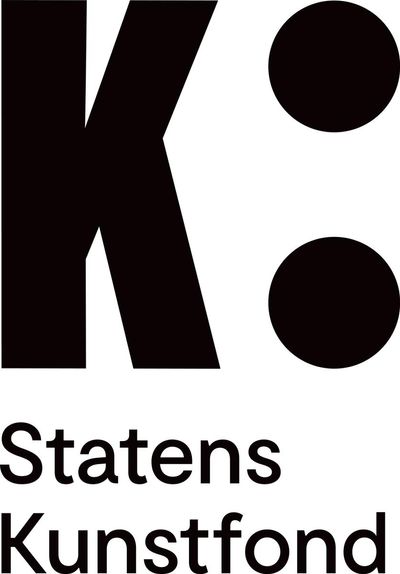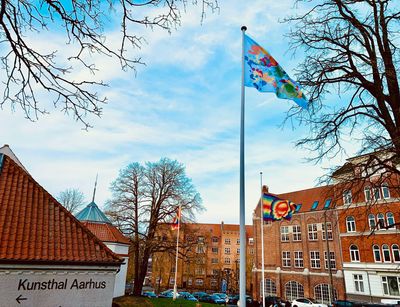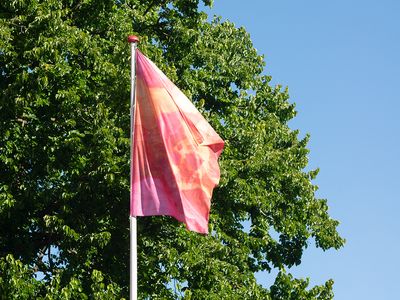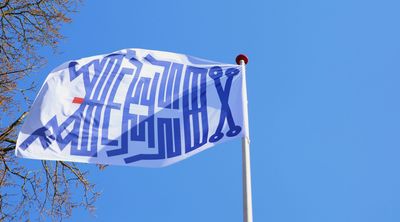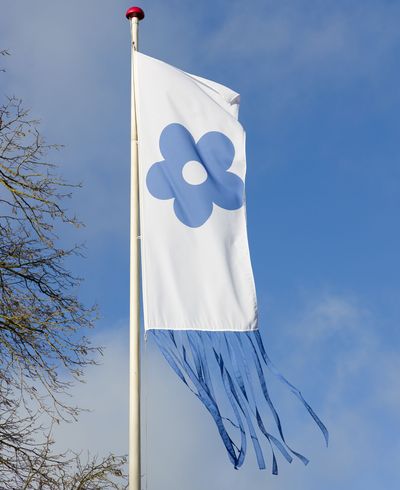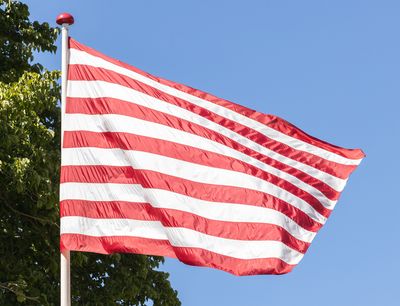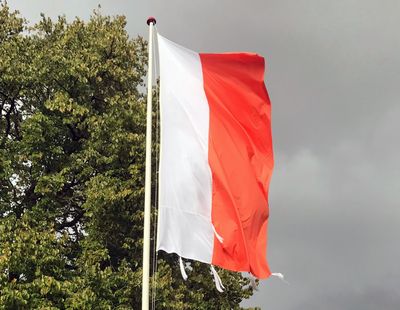A Flag is a Piece of Fabric
–
–
A flag is a signal-giving piece of material. A loaded object and icon, which is often used as a symbol of politics, status, war, peace, territories, in connection with geopolitics and sports, but also the logo for various trademarks. All of the independent countries have flags, but there are also flags – such as the freestate Christiania's characteristic flag or (without comparison) the ISIS flag – which has iconic status, even though they do not represent nation states.
Flags produced by artists have a long and interesting history. There are many good reasons why flags are still relevant to the process and used within artistic and aesthetic practice. The symbol of the flag is used extensively in works during the last 100 years of art history. They are often covered with history and meaning, sometimes isolated like Jasper Johns flags (1954) or David Hammons African-American Flag (1990). Other times, the flag comments on a major political debate, for example, Eugène Delacroix, La Liberté guidant le peuple (1830), Poul Gernes proposal for an EC flag (1972), Daniel Buren's minimalistic Les Guirlandes (1982) on Documenta 7 in Kassel or Ai Weiwei's flag in connection with the 70th anniversary of the Universal Declaration of Human Rights (2018).
Since 2017, the park surrounding Kunsthal Aarhus has served as the venue for an annual outdoor exhibition featuring art flags: A Flag is a Piece of Fabric. The first flag was created for Kunsthal Aarhus 100 Anniversary by the artist Bodil Nielsen.
𝗔𝘆-𝗢, 𝗥𝗮𝗶𝗻𝗯𝗼𝘄 𝗟𝗮𝗻𝗱𝘀𝗰𝗮𝗽𝗲 #𝟮𝟬𝟮𝟱, 𝟮𝟬𝟮𝟱
In 2025, the exhibition project A Flag is a Piece of Fabric continues with three colorful flags by the Japanese artist Ay-O, who was a central figure in the experimental Fluxus movement of the 1960s and 70s. Ay-O is known for his “rainbow happening” in the Eiffel Tower back in 1987, where a 300 meter long rainbow flag was installed at the top. Ay-O has also played a crucial role in bridging the gap between Western and non-Western art.
In 2025, the exhibition is titled Ay-O: Rainbow Landscape #2025 and is realized in collaboration with Tiger Tanuki, run by art historian and curator Malene Wagner. Kunsthal Aarhus has installed two additional flagpoles for the realization of the exhibition, significantly expanding the concept compared to previous years.
𝗥𝗮𝘂𝗹 𝗪𝗮𝗹𝗰𝗵, 𝗛𝗲𝗮𝘁 𝗙𝗹𝗮𝗴 (𝗔𝗮𝗿𝗵𝘂𝘀), 𝟮𝟬𝟮𝟰
With Heat Flag (Aarhus) Raul Walch visually presents a recent hot July month in Denmark in watercolour. The title refers to heat maps where certain colours are associated with different temperatures but these colours can also represent elevation changes or other gradients.
The original medium of watercolour, which is transfer-printed onto flag textile, is informed by this, the colours bleed and blend. A fluidity that cannot be contained. The water surrounding the border of Denmark appear lighter in colour but not cold. Rising temperatures mean rising water levels which besides its impact on nature and wildlife will have an effect on the country. The colour red indicates alarm or danger. Then, Walch questions “when will the whole flag turn red and how deep will we let the shades get?”
𝗗𝗼𝗻𝗴𝗵𝗲𝗲 𝗞𝗼𝗼, 𝗚𝗼𝗼𝗱 𝗟𝘂𝗰𝗸, 𝟮𝟬𝟮𝟮
For this year's artistic flag at Kunsthal Aarhus, the Korean artist Donghee Koo has been inspired by a well-known Korean talisman. The symbol for happiness and wish fulfilment, which is why the title of the work is fittingly Good Luck.
The talisman is made up of a combination of Chinese characters, which stems from the now past mix of Korean and Chinese writing called Hanja.
The writing can be difficult to decipher as letters. Donghee Koo was interested in the talisman's dual-sided qualities of a scripture part and an abstract part similar to a hieroglyph, in which the form, among other things, appears to show a reptile.
The artist hopes that the flag can help bring good luck to the Kunsthal Aarhus guests and passers-by through 2022.
𝗗𝗶𝘁𝘁𝗲 𝗚𝗮𝗻𝘁𝗿𝗶𝗶𝘀, 𝗞𝗷æ𝗿𝗹𝗶𝗴𝗵𝗲𝗱, 𝟮𝟬𝟮𝟭
While flags often signal nationalism or a particular policy and location, the artist Ditte Gantriis has chosen to detach her work from these immediate symbolic values through an unconventional format and motif: The flag is vertical, fringed and adorned by a single flower.
The innocent flower that waves in the wind is a response to the flag as a symbol of demarcation and nationalism. The art flag represents the child, nature and what is not defined by its limit.
Gantriis sees the art flag as a condensation of her exhibition contribution to the grand exhibition GO EXTREME. For the exhibition, Ditte Gantriis has also designed another flag that remixes Go Extremes own logo. However, this official GO EXTREME flag will first be shown at the opening of the exhibition.
𝗦𝗼𝗽𝗵𝗶𝗮 𝗜𝗼𝗮𝗻𝗻𝗼𝘂 𝗚𝗷𝗲𝗿𝗱𝗶𝗻𝗴, 𝗥𝗲𝗯𝗿𝗲𝗮𝘁𝗵𝗲𝗿: 𝗧𝗵𝗲 𝘄𝗶𝗻𝗱 𝗮𝘀 𝗮 𝗱𝗿𝘂𝗻𝗸, 𝟮𝟬𝟮𝟬
The flag in Kunsthal Aarhus Skulpturpark, Rebreather: The wind as a drunk, was shaped like a windsock. A windsock is a cylinder of fabric used to show the direction and strength of the wind. Windsocks are typically installed in airports and at locations with a risk of gas-leeks. A windsock is divided into segments which are filled one by one with air depending on how windy it is.
The segments on Rebreather: The wind as a drunk were used as a sequenced frame that shows a determined movement: The wind takes the shape of a face blowing wind.
In more than one way, Gjerding’s work was an animation of nature. The real wind animated the work; it brought it to life and made it possible for the work to unfold as an animation of the wind itself. Rebreather: The wind as a drunk depicted nature as something which possess human traits – a drunkard who is blowing. As the wind blows stronger and stronger the drunkard spins more and more out of control.
𝗛𝗲𝗻𝗿𝗶𝗸 𝗣𝗹𝗲𝗻𝗴𝗲 𝗝𝗮𝗸𝗼𝗯𝘀𝗲𝗻, 𝗦𝘁𝗿𝗶𝗽𝗲𝘀 𝗮𝗻𝗱 𝗦𝘁𝗿𝗶𝗽𝗲𝘀, 𝟮𝟬𝟭𝟵
In the flagpole at Kunsthal Aarhus flew a banner created by artist Henrik Plenge Jakobsen in 2019: Stripes and Stripes. The piece was sewn out of material taken from two Stars & Stripes flags, the official flag of the United States of America. Plenge Jakobsen raised the flag himself at a ceremony held in February 2019 in relation with the finissage of the exhibition Post Institutional Stress Disorder (PISD).
Plenge Jakobsen’s artistic practice revolves around a critique of the fundamental political, economic and social structures underpinning modern society. He often designs works for public spaces, letting them intervene in and interfere with their settings.
𝗕𝗼𝗱𝗶𝗹 𝗡𝗶𝗲𝗹𝘀𝗲𝗻, 𝗙𝗲𝘀𝘁𝗹𝗶𝗴 𝘁𝗲𝗴𝗹𝗿ø𝗱, 𝟮𝟬𝟭𝟳
The colour festlig teglrød (festive brick-red) adorned the outer walls in the years 1954 – 1969. On occasion of the 100-year-anniversary of Kunsthal Aarhus artist Bodil Nielsen recreated the colour, which now decorates one of the walls in the café and the restroom.
Supported by

